As the Inn prepares to celebrate 40 years, we look back on their 30th anniversary.
Classic country coupled with creative cuisine: The Inn at Little Washington is the crème de la crème
By Anita L. Sherman
Valentine’s Day is over, and no doubt engagement rings were part of the menu. It’s been another amazing performance. From the kitchen to the intimate tables, Chef Patrick O’Connell and his staff have dazzled and delighted scores of love-struck guests in his world-renowned and richly romantic Inn at Little Washington. Hide a new mink coat in the closet? Conceal a string of pearls in a bed of oysters? Not a problem. Disappointment is a word not in their vocabulary, and special requests are never a chore. Now, it’s Sunday afternoon and O’Connell, who lives nearby, will soon be heading over to his inner sanctum to create yet another gastronomic wonder.
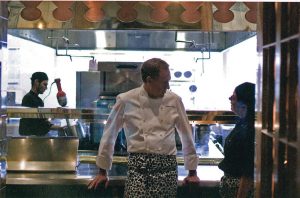
Sporting the Inn’s distinctive Dalmation-spotted apron and pants, O’Connell confers with one of the staff. There are now well over 100 employees at the Inn.
Camera crews are scheduled the next day to capture on film some part of the essence of this place and all that it has become over its 30-year history. The video is being produced as part of a grand gala event to be held in Washington, D.C., and will not only commemorate the Inn’s anniversary, but Chef O’Connell’s contribution to the culinary world.
No doubt a cookbook could be written and filled with recipes of rave reviews, appetizers of accomplishments, and heavenly desserts fashioned from dreams with ingredients like sublime, sophisticated, sensuous, lavish, opulent, elegant, charming, impressive, divine, outstanding … and the list of accolades goes on!
O’Connell is a master at what he does: creating not only fine food but, perhaps more importantly, the ambiance in which to enjoy its flavors. His settings are unhurried and meant to soothe, yet with every sense titillated and teased by an eclectic and oftentimes eccentric presentation. His menus change with the seasons, even with the weather, and they are often tossed about like leaves on a crisp autumn afternoon. A wizard of whimsy, O’Connell is ever offering his customers little surprises and fanciful touches.
It’s been 30 years and O’Connell is still smiling whether on stage as maestro of his kitchen or gliding effortlessly to greet a politician, European chef, celebrity, or a newly married couple who has come to dine.
What keeps O’Connell inspired and energized? “A challenge craves a challenge,” said O’Connell, “and our challenge is not only to maintain, but to make it better in every way, every day.” O’Connell credits his diverse staff—now numbering around 120—with providing the impetus to make that happen. “No one person has all the ingredients,” continued O’Connell. “It’s the total experience of working together in collaboration to do what we do. If food were the only element, it would be far less challenging.”
CRITIC’S CHOICE
O’Connell was born in Washington, D.C. The family moved to Maryland and as a teenager he worked at a small carryout restaurant in Clinton. The old-school restaurant owner may have been one of his first mentors. O’Connell laughed as he recalled those days, “It was before fast food really took hold.” Somewhere between the battered onion rings and pickle relish as well as some work in the theatre, the seeds of O’Connell’s future genius were planted. It was at Catholic University, which O’Connell attended on a theatre scholarship, that he met his future partner, Reinhardt Lynch, who hailed from Indiana. Heading west to rural Rappahannock County, the two took up farming, and O’Connell soon had a plethora of fresh ingredients for his food palette. He spent long hours reading cookbooks in an unheated farmhouse and would often frequent the county library to get warm. Together, the two started a catering business, and their reputation grew along with their combined desire to create something really magnificent. They later purchased a run-down building on the corner of Middle and Main Street in the historic town of Washington. The town, surveyed by a young George Washington in 1749, preceded its larger cousin, Washington, D.C., which wasn’t established for another 51 years. For many, this quiet, quaint, and rural town may have seemed an unlikely setting for a fine-dining establishment, but for O’Connell and Lynch it was the perfect place in Rappahannock County, their home.
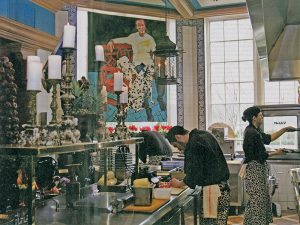
With Gregorian chants often playing in the background,
Chef Patrick O’Connell’s blue and white porcelain-tiled “sanctuary” is not the typical restaurant kitchen
O’Connell’s passion for the intensity of the restaurant business, sparked by his stint as a short-order cook, was now married to his passion for the theatre. The former Merrill’s Garage morphed into The Inn at Little Washington, and its doors were opened to welcome its first guests in February of 1978.
Fueled by their catering clientele, O’Connell and Lynch didn’t expect that their business would grow much beyond the surrounding three to four counties in that first year, but they were wrong.
Food critic John Rossen, then with the Washington Evening Star, came to dine. He asked O’Connell if he wanted him to write a review and let the larger world know that they existed. “I was startled,” remembered O’Connell. “Of course we wanted a review.” Rossen had been remarkably impressed and told O’Connell, “It might change your whole life.”
At that time, the Inn’s staff consisted of only O’Connell, Lynch, and one young server. “I’d be cooking and answering the phone at the same time,” laughed O’Connell.
Once Rossen’s review caught the eye of curious and discerning food connoisseurs in D.C., the Inn became a destination food mecca. The phones started ringing and a steady stream of diners flooded into town. No one seemed to mind the bucolic 70-mile drive west to get there; in fact, it made it just that much more appealing and tantalizing for inquiring minds and appetites.
Once comfortably ensconced at the Inn, folks found that they weren’t in any hurry to leave.
The upstairs of the old Merrill’s Garage had been a combination dance hall and gymnasium. What it needed was a bit of foreign flare, so O’Connell and Lynch called upon Joyce Evans, set designer for London’s Royal Opera, who turned the second floor into a series of six distinctly decorated and inviting rooms resembling the epitome of an English country inn. With a restaurant and now rooms for overnight guests, the full potential of the Inn was quickly being realized. O’Connell and Lynch continued to add staff.
By 1988, when the Inn at Little Washington had celebrated a decade of existence, it was flying the flag of the elite Relais & Chateaux, a group of small luxury hotels and restaurants with exacting standards and ratings for the five “C’s” of hospitality: character, courtesy, calm, comfort, and cuisine. In the world of food, wine, and hospitality, the Inn was now included in this revered membership, opening its doors to the sophisticated European traveler. For O’Connell, it was “acknowledgment that America was growing up in terms of taste, style, and cuisine.” He wasn’t alone in his assessment. The Inn had already turned the heads of noted food journalists like Craig Claiborne of the New York Times and Phyllis Richman of the Washington Post.
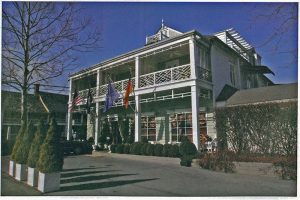
Flags unfurled and flying in the breeze, the Inn welcomes visitors at the corner of Middle and Main in Washington. Thirty years ago the building was converted from Merrill’s Garage. It didn’t take long for food critics to discover the new restaurant.
1989 was unprecedented as the Inn at Little Washington became America’s first and only inn to earn Mobil Travel Guide’s prestigious Five-Star Diamond Award from the American Automobile Association as well as the Zagat Hotel Survey’s highest national rating and the first “perfect” score for food.
Favorable reviews from food critics are always a plus, but certainly not without pressure for O’Connell and his staff. “You never know when they are coming,” remarked O’Connell. “Some of them even wear disguises, going to great extremes even though it’s not necessary; there is little you can do that is remarkably different than any other night.” On a recent icy evening, O’Connell was informed that a Washington Post food critic had arrived under the pseudonym of “Mr. Cook” to celebrate his mother’s 80th birthday. Within minutes, the power went out but they weren’t about to close their doors. “We went into emergency mode,” said O’Connell, “and by the time I walked over to greet him, the power had been restored. Our guardian angel had arrived, and we finished wonderfully, we think.”
O’Connell lamented the fact that food critics aren’t what they used to be. Many are no longer schooled via extensive restaurant tutorial visits, and reference points have changed dramatically. “The more traveled and knowledgeable they are, the more they will appreciate what we are doing here;” said O’Connell. “But it’s difficult now; we’re on a third generation of restaurant critics and their cost-to-value ratio is viewed very differently. They get younger and younger, the papers’ budgets are smaller, and their reference point is often a noisy restaurant downtown where there are a lot of distractions and they don’t have to focus on an intimate conversation.”
Self-taught, O’Connell and Lynch made a practice of spending at least a month a year touring Europe, visiting restaurants and taking notes on what the very best establishments had to offer in terms of cuisine and service. “It was perhaps the most intelligent thing we ever did,” said O’Connell, “closing the restaurant in January and taking this pilgrimage to the greatest restaurants in the world. We did this for 18 years, and it was an education in itself as we experienced them from the perspective of guests. No one had it all or was perfect—in fact, some had tragic flaws. It was pretty amazing and we used what we learned as a measuring stick.”
“In France, for instance,” noted O’Connell, “it’s not unusual in a wonderful restaurant to have that exhilarating feeling of theatricality, a sense that you are the star in a film; it’s never money first.”
For O’Connell, this is a great tragedy in American culture that the celebration of food, how it is prepared, served and savored, is an experience often measured in terms of dollars. “It’s a celebration that you can’t create instantaneously and one that can’t be replicated,” noted O’Connell, referring not only his efforts but to those of his staff who, to him, are priceless.
NO ROOM AT THE INN
In 1990, O’Connell and Lynch proposed an extravagantly viewed, large-turreted addition that would have added more suites, an indoor swimming pool, and formal gardens to their existing building, plus expanded parking. Neither O’Connell nor Lynch were prepared for the flurry of ruffled feathers that their proposal would cause among town locals and officials who viewed any change as one for the worst. Threatened lawsuits and frayed nerves left supporters on both sides weary. The resort-like plan was ultimately denied.
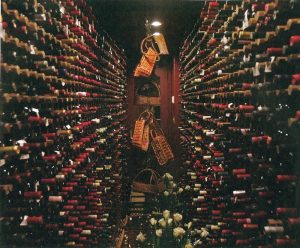
The Inn’s “day” wine cellar houses only a small fraction of the 15,000 bottles of wine offered by the Inn’s extensive inventory. Dinner guests can choose from a selection of some seven tastings paired with wines.
Despite this setback and thoughts of relocating the Inn, O’Connell and Lynch stayed steadfast with their commitment to the vision of the Inn and its location.
“Well, I learned something from that,” mused O’Connell. “I thought at the time that our patrons would want to be in a selfcontained cocoon. That was our perspective, but in hindsight, we found that they would much rather be part of the rich landscape that is already here.”
The Inn’s 20th anniversary in 1998 was celebrated with the unveiling of a $5 million renovation.
With Gregorian chants often playing in the background, O’Connell refers to his kitchen as his “sanctuary,” and it is here along with a host of sous chefs clad in Dalmatian-spotted pants that the real show stoppers are created. For several hundred dollars extra, patrons can get a ringside seat in this beautiful blue and white porcelain-tiled palace for their own private viewing.
The kitchen is as well-appointed as the rest of the Inn with its coffered ceiling, large bay windows, and gigantic Vulcan stove built in France and helicoptered to the Inn as a separate piece. The kitchen easily accommodates more than a dozen working chefs and assistants with O’Connell presiding as lord and master. If anyone forgets why they are there, O’Connell has posted his philosophy of the five stages of dining as a reminder: anticipation, trepidation, inspection, fulfillment, and evaluation.
O’Connell’s staff is international and this global confluence of characters creates a unique atmosphere. “We’re bringing staff from many different countries with many different work ethics,” said O’Connell. “We have Americans working alongside Russians. We have staff who will happily do whatever is needed or required and others who overanalyze, but we have an infectious atmosphere, a terrific balance where every day we are inspiring one another.”
Employees at the Inn are exposed to more than O’Connell’s high expectations both in and outside of the kitchen. “They have opportunities to meet people they wouldn’t otherwise meet and it’s an education” remarked O’Connell. When First Lady Laura Bush came to celebrate her birthday with a host of her lady friends, she had no qualms about a group photo taken in the kitchen. “She couldn’t have been more inclusive and gracious with the staff,” noted O’Connell. The same was true when Barbra Streisand visited. “They come to the country and they become more real, relaxed, and relate to the staff in an open and genuine way. It’s very exciting and a real benefit.”
When O’Connell met Alan Greenspan for the first time, he had been forewarned that Greenspan was difficult to understand—from a different planet—and only spoke in code. O’Connell found that not to be the case at all. “He was the nicest, most pleasant and easy conversationalist, a very regular guy,” chuckled O’Connell.
In April 1997, Alan Greenspan was wed to NBC’s Andrea Mitchell in a wedding held at the Inn. It brought out the likes of Barbara Walters and Senator John Warner. Greenspan is a favorite and regular patron, celebrating his birthday there each year. He, along with O’Connell’s mother Gwendolyn, are currently lobbying to get their favorite dessert back on the menu: chocolate mint fantasy ice cream. “We make it with fresh green mint; it’s very refreshing and my mother’s fixated with it, has it every night,” said O’Connell. Greenspan chided O’Connell, “Our two votes should have some influence.”
ACTING LOCALLY
O‘Connell is a perfectionist and every ingredient that he uses is a precise measurement of his devotion to his craft. As such, O’Connell is blessed to have his restaurant located in Rappahannock where there is an abundance of fresh produce that he prides himself on using.
Take for instance Sunnyside Farms. “They are terrific neighbors and are continuing in the tradition that David Cole began; their greenhouses are producing for us,” said O’Connell, who noted that the Inn has recently added a little apple orchard with heirloom varieties. As has been a tradition for many years at the Inn, locals form a line at the backdoor bringing eggs, turnips, cabbages, morels, fruits, and more, as the French would say, “cuisine de terroir.” O’Connell basks in the bounty that the county offers. “And seafood, it’s one of my greatest victories!” exclaimed O’Connell, who gets fresh seafood delivered daily from Dulles Airport. “One of my former sous chefs is now a fish wholesaler in Hawaii; he’ll call me at midnight and we’ll talk about what he has picked out for us. He’s a terrific young man and he knows what quality we’re looking for.”
Menus at the Inn are personalized, so be ready to smile when you open yours and it reads, “A Warm Welcome to the McNear Party“ or “Happy Anniversary, John and Diane.”
Guests for dinner can choose from a selection of some seven tastings paired with wines. These might include potato crusted tuna wellington with caponata ravioli and sauce bearnaise served with a Spanish gran familia, rioja, or their three-course selections with choice of dessert. Always with unusual and artistically prepared combinations, many of O’Connell’s creations are given fanciful names. Seared tuna sashimi with daikon radish and cucumber sorbet, for instance, makes its entrance as “Fire and Ice.”
The Inn is pure class with dishes delivered in synchronized service, but style doesn’t mean stuffy, and elegant doesn’t preclude a bit of quirkiness.
O’Connell has fun, so if foie gras isn’t your thing, indulge in one of his favorites—macaroni and cheese with Virginia country ham and shaved black truffles.
The Inn’s wine cellar contains some 15,000 bottles, and the sommeliers know every one of them.
COMMUNITY CONNECTIONS
Over the years, both O’Connell and Lynch have served in local government. Lynch was vice mayor and served on the Washington Town Council while O’Connell is chairman of the Architectural Review Board, whose mission is to preserve the historic character of the town. Each spring, the Inn has sponsored the annual 10-K Fodderstack Race, and at many fundraisers the prized auction item is a dinner for two at the Inn. Local art students vie for a chance that their design will be chosen for the Inn’s Christmas card. O’Connell offers cooking classes and in December at the Annual Christmas Parade, staff at the Inn were a hit in their brilliant blue-feathered headdresses.
The Town of Washington has a population of fewer than 175. They have no property tax and don’t need one, according to Mayor Eugene Leggett. A food and lodging tax imposed in the mid-80s produces sufficient revenue from the town’s restaurants and bed and breakfasts, and most notably the Inn, so that the tiny populace can breathe easy.
BLACK AND WHITE
If you’re lucky, you’ll arrive on an evening when the Inn’s two mascots, Pearl and JoBe, are curled up in the lobby like royalty on satin pillows. These two perky Dalmatians are the inspiration for many of the aprons and cooking pants that you’ll find in the Inn’s shops. Many years ago, Inn staff bought their predecessors—DeSoto and Rose—as gifts for O’Connell and Lynch, a distraction from their 24/7 workaholic pace in building what today is a world-class destination.
For O’Connell, change is the only constant. Now, as sole proprietor, he is prepared to take the Inn to even higher levels.
A phone rings. It’s one of his staff. Notable French chef Alain Ducasse is staying at the Inn’s latest and most magnificent addition, The Claiborne House. He will be having lunch soon.
“We’ll need to prepare him something very special,” said O’Connell.
You don’t have to be a French chef, celebrity, or noted economist when you walk through the doors for dinner or to spend the night. Your desire should be simple—to be awed, intrigued, comforted, and restored by the total ambiance of this very special and magical place hidden in the heart of the Blue Ridge Mountains.
Do come Inn.
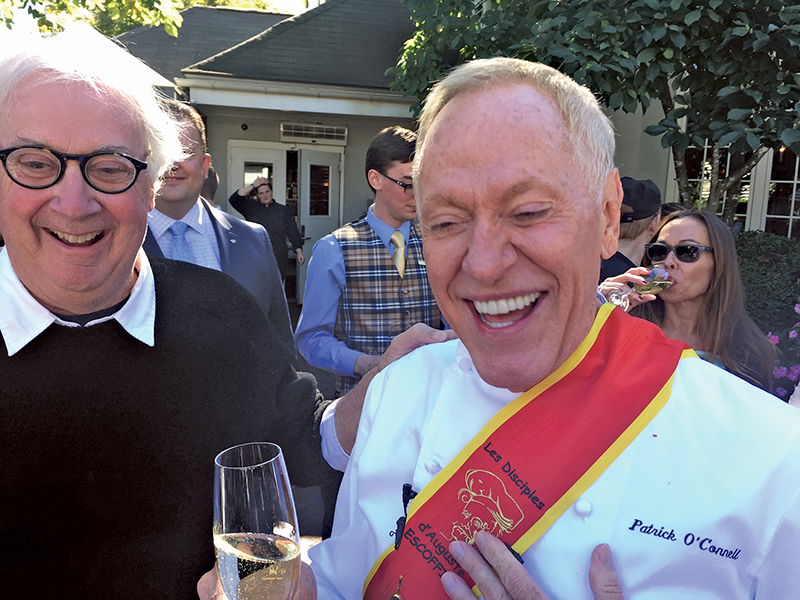
Postscript: In 2016, Michelin Guide launched its first guide to Washington, D.C., and the Inn was one of only three restaurants recognized. This October, O’Connell celebrated retaining two Michelin stars with his staff and locals, including Washington, Va., Mayor John Fox Sullivan, left.
Leave a Reply